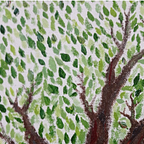Gender Realizations and Authenticity
Earlier this year, I uncovered a truth about myself that had previously eluded me. A piece of the puzzle of my identity clicked into place when I realized that I’m non binary.
At times, the truth can be a double-edged sword, and to me, this truth certainly was. On one hand, I was happy that I finally figured out my gender identity and which pronouns I prefer to use. But on the other hand, I had to worry about having to hide another aspect of my identity because not everyone in my life would accept it.
Is it better to know a dangerous truth than to retreat into the safety of falsehood? To me personally, I’ve found that the answer has turned out to be yes in this situation.
Allowing myself to acknowledge the gender I really am has made me more in tune with myself. It allowed me to put into words my vague feelings surrounding gender that I had previously dismissed as a general dislike of gender roles. Having ways to describe my gender identity and understand my feelings surrounding it was empowering.
My understanding of how gender fits into my identity has also changed over time, as I have come to realize what it means to me. This began with me questioning whether or not I actually identified as my AGAB, and continues to evolve.
At first, I only identified with one specific gender label: Agender. This was because at the time, I felt that I didn’t have a sense of identifying as any particular gender. To some extent, I still feel that this describes me. However, I also somewhat see my gender as being ‘neutral’ or ‘in-between’ in some ways.
For this reason, I additionally adopted the terms Androgyne and Neutrois to describe my gender identity; these refer to androgynous and neutral gender identities respectively. I also realized that in addition to they/them pronouns, I prefer lea/leaf neopronouns.
And while I’m not entirely open about my gender and pronouns to everyone I know or meet, I’m glad that I am aware of these aspects of my identity and that I can be out to some people in my life who are accepting.
Additionally, I believe that it is important to acknowledge that there us no singular trans narrative. A large part of why it took me so long to figure out my gender identity was because I thought I must be cis, as I did not seem to fit the mainstream trans narrative. I had this misconception that if I were ‘truly’ trans, I would have known from a young age and experienced severe bodily dysphoria.
Obviously, this is an untrue byproduct of societal conditioning that paints the lives of trans people in a monolithic manner. When you don’t seem to fit a narrative expected of people who share your identity, it’s difficult to see yourself as that aspect of who you are.
It wasn’t that I had this misconception because I did not know that trans peoples’ experiences can fall outside of the expected ones, or believed there was one universal trans experience that stayed consistent. Rather, I internalized a bias that caused me to consider trans people who ‘knew’ from a young age and experience bodily dysphoria as more valid.
I applied this standard more to myself than other people. Initially, I was hesitant to actually question my gender identity because I was worried that I was just a gender-nonconforming cis person and was somehow impinging on the identities of ‘actual trans people’ by questioning my gender.
I was concerned that trans people would be seen as less valid if people questioned their gender and turned out to be cis, but this concern was rather baseless and rooted in preventing already prejudiced people from somehow becoming more prejudiced. That is, a person who questions their gender and turns out to be cis does not invalidate trans people and our identities in the slightest, but transphobic people may consider such a scenario to be ‘evidence’ that trans or gender-questioning people are invalid.
People can question their gender or orientation, and questioning people are as much a part of LGBT+ acronym as people who are already aware of their gender or orientation. It’s also perfectly valid for people to first identify one way, then realize that other labels fit who they are better. Overcoming my initial hesitation to question my gender was an integral part of acknowledging my non-binary gender identity.
Even the simple act of questioning whether or not I truly identified with my AGAB felt more authentic than just going along with my AGAB as I had done before. It was, in essence, a step closer to figuring out my identity gender-wise.
Put simply, it was affirming for me to be able to question my gender identity and arrive at the conclusion that I’m non binary. I feel more like myself after allowing myself to identify as the gender I truly am. To me, it’s an illustration of how authenticity and self-awareness go hand in hand. It’s reassuring to me that I can be true to myself and others I’m out to with respect to my gender identity.
